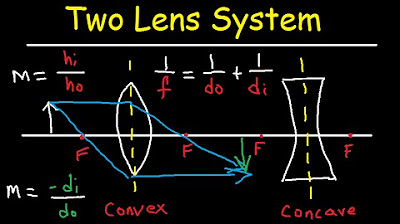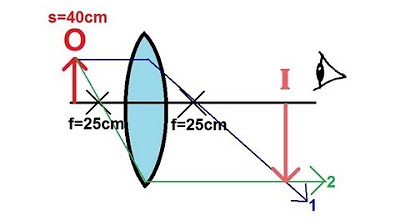Picture of a Tree - Thin Lens Equation | Physics with Professor Matt Anderson | M27-18
TLDRThe video script explains the thin lens equation, which mirrors the mirror equation, as \( \frac{1}{d_o} + \frac{1}{d_i} = \frac{1}{f} \). It clarifies the sign conventions for distances in lens optics, emphasizing that all measurements are positive. Using a real-world example of photographing a tree at 2 meters with a 10 cm focal length lens, the script demonstrates how to calculate the image distance, resulting in an approximate value of 0.105 meters. This example illustrates why point-and-shoot cameras and smartphones can focus on distant objects, as their image distances approach the lens's focal length.
Takeaways
- 🔍 The thin lens equation is similar to the mirror equation, expressed as \( \frac{1}{do} + \frac{1}{di} = \frac{1}{f} \).
- 📏 The sign convention for distances in the lens equation is different from that of a mirror; all distances are considered positive.
- 🌳 The focal length 'f' is a positive value and represents the distance from the lens to the point where parallel rays converge.
- 📷 In the example, the object (tree) is placed 2 meters away from the camera lens with a focal length of 10 centimeters.
- 🧩 To find the image distance 'di', rearrange the lens equation to \( \frac{1}{di} = \frac{1}{f} - \frac{1}{do} \).
- ✂️ Multiply through by 'do' and 'f' and divide by the common denominator to solve for 'di'.
- 🔢 Substitute the given values into the equation to calculate 'di', which turns out to be approximately 0.105 meters.
- 📉 As the object distance increases, the image distance approaches the focal length, making distant objects appear in focus.
- 📱 Point-and-shoot cameras and smartphone cameras can focus on objects at great distances because the image distance is close to the lens's focal length.
- 🔄 The process involves understanding the lens equation, applying it to a real-world scenario, and performing the necessary calculations to find the image distance.
- 📚 The script serves as an educational tool to explain the principles of optics and how they apply to everyday devices like cameras.
Q & A
What is the thin lens equation?
-The thin lens equation is given by \( \frac{1}{do} + \frac{1}{di} = \frac{1}{f} \), where \( do \) is the object distance, \( di \) is the image distance, and \( f \) is the focal length of the lens.
What is the difference between the lens equation and the mirror equation?
-The lens equation and the mirror equation are the same in form, but the sign convention for the distances is different. For a lens, distances are positive regardless of being to the left or right of the lens, whereas for a mirror, distances are positive to the left and negative to the right.
What is the focal length of a lens?
-The focal length \( f \) is a positive value that represents the distance from the lens to the point where parallel rays of light converge to form an image.
How is the object distance measured in the lens equation?
-The object distance \( do \) is measured as a positive number from the center of the lens to the object, regardless of whether the object is to the left or right of the lens.
What is the significance of the image distance in the lens equation?
-The image distance \( di \) represents the distance from the lens to the location where the image is formed. It is also a positive number and is crucial for determining the position and size of the image.
How can you find the image distance using the lens equation?
-To find the image distance, you can rearrange the lens equation to \( \frac{1}{di} = \frac{1}{f} - \frac{1}{do} \) and solve for \( di \) using the known values of \( do \) and \( f \).
In the given example, what is the object distance to the tree?
-In the example, the object distance \( do \) to the tree is 2 meters.
What is the focal length of the camera lens in the example?
-The focal length \( f \) of the camera lens in the example is 10 centimeters.
How is the image distance calculated in the example provided?
-The image distance is calculated by substituting the values of \( do \) and \( f \) into the rearranged lens equation, resulting in \( di \) being approximately 0.105 meters.
Why do point and shoot cameras or smartphone cameras have a wide focus range?
-Point and shoot cameras and smartphone cameras have a wide focus range because the image distance for distant objects is nearly the same as the focal length of the small lens, allowing for objects at various distances to be in focus.
What happens to the image distance as the object gets further away from the lens?
-As the object gets further away from the lens, the image distance gets closer to the focal length of the lens, which is why distant objects can appear in focus.
Outlines
🔍 Understanding the Thin Lens Equation
This paragraph explains the thin lens equation, which is analogous to the mirror equation, as 1/f = 1/do + 1/di, where 'f' is the focal length, 'do' is the object distance, and 'di' is the image distance. It clarifies the sign convention for these measurements, emphasizing that all distances are considered positive for a positive lens. The paragraph provides an example of calculating the image distance for a tree 2 meters away from a camera with a 10-centimeter focal length, resulting in an image distance of approximately 0.105 meters, close to the focal length. It concludes by explaining the practical application of this principle in point-and-shoot cameras and smartphones, which can focus on objects at various distances due to the image distance being close to the lens's focal length.
🌳 Focusing on Distant Objects with Point-and-Shoot Cameras
This paragraph discusses the ability of point-and-shoot cameras and smartphone cameras to focus on objects at very far distances. It explains that this is possible because the image distance in such cameras is nearly the same as the focal length of the lens. This characteristic allows for a wide range of objects, from near to far, to be in focus, making these types of cameras convenient for quick snapshots without the need for manual adjustments.
Mindmap
Keywords
💡Thin Lens Equation
💡Mirror Equation
💡Focal Length
💡Object Distance
💡Image Distance
💡Ray Tracing
💡Positive Lens
💡SI Units
💡Camera Lens
💡Point and Shoot Cameras
💡Smartphone Camera
Highlights
The thin lens equation is analogous to the mirror equation, with the formula 1/do + 1/di = 1/f.
Sign convention for the lens equation differs from the mirror equation.
Focal length 'f' is considered positive for a converging lens.
Object distance 'do' is positive when the object is to the left of the lens.
Image distance 'di' is also positive, regardless of the image's position relative to the lens.
Ray tracing techniques can be used to determine the image formation.
A practical example involves calculating the image distance 'di' for a camera lens focused on a tree.
The camera lens to tree distance 'do' is given as 2 meters.
The camera's focal length 'f' is approximately 10 centimeters.
The lens equation is rearranged to solve for 'di'.
Conversion of units from centimeters to SI units is necessary for the calculation.
The calculated image distance 'di' is close to but slightly greater than the focal length 'f'.
For distant objects, the image distance approaches the focal length of the lens.
Point and shoot cameras and smartphone cameras can focus on objects at great distances due to this principle.
The practical application of the lens equation in photography is demonstrated.
The importance of understanding the lens equation for focusing mechanisms in cameras is highlighted.
The transcript provides a clear explanation of the thin lens equation and its application in real-world scenarios.
Transcripts
Browse More Related Video

Physics - Optics: Lenses (1 of 4) Converging Lens

Thin lens equation and problem solving | Geometric optics | Physics | Khan Academy

The Camera | Physics with Professor Matt Anderson | M28-20

Multiple Two Lens System with Diverging and Converging Lens

Physics - Optics: Lenses (3 of 4) Converging Lens

Physics - Optics: Vision Correction (4 of 5) Farsighted
5.0 / 5 (0 votes)
Thanks for rating: